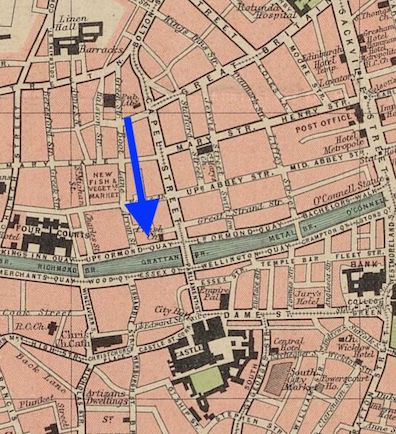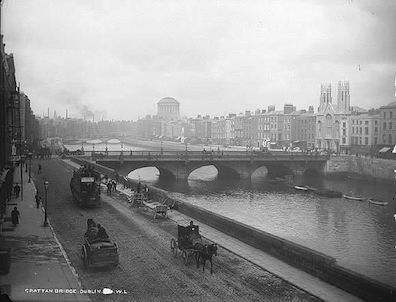Sirens opens with the two barmaids looking "over
the crossblind of the Ormond bar" at the viceregal
procession which is passing by on the pavement in front of the
hotel. Several short paragraphs later Miss Douce darts "to the
backmost corner, flattening her face against the pane" to peer
at the receding carriages. These details imply that the bar
counter must have run perpendicular to the street, ending at
the front wall where blinds screened the lower half of the
windows. A door likely opened directly into the bar from the
street, but if so another front door must have led to the
hotel rooms upstairs. When Bloom leaves the restaurant he
walks through the bar into a hallway leading to this other
front door: "By deaf Pat in the doorway straining ear Bloom
passed.... By rose, by satiny bosom, by the fondling
hand, by slops, by empties, by popped corks, greeting in
going...Bloom in the Ormond hallway heard growls and
roars of bravo" for Ben Dollard's performance. The dining room
sits on one side of the bar, then, and a hallway on the other.
The interior of the saloon, used for smoking and for small
evening concerts, must have been visible from the bar, because
Simon Dedalus looks from the bar "towards the saloon door"
and says, "I see you have moved the piano." Miss Douce
explains that a piano tuner visited earlier in the day, "tuning
it for the smoking concert." The narrative notes that
Simon, having finished his drink, "strayed away." Soon the hum
of a tuning fork emerges from the saloon, and soon after that
the notes of Goodbye,
Sweetheart, Goodbye, played by "sensitive hands.
Brightly the keys, all twinkling, linked, all harpsichording."
The saloon, it appears, had a raised platform for performers
and a painting on one wall: "— M'appari, Simon,
Father Cowley said. / Down stage he strode some
paces.... Softly he sang to a dusty seascape there: A
Last Farewell. A headland, a ship, a sail upon the
billows. Farewell. A lovely girl, her veil awave upon the wind
upon the headland, wind around her." When Ben Dollard's big
bass voice ascends "to the quivery loveshivery roofpanes,"
it becomes apparent that the saloon is in a one-story part of
the building lit by a skylight.
As for the dining room, after Bloom crosses the Grattan
Bridge from Wellington Quay to Ormond Quay, he sees Boylan
doing the same thing in a car.
He follows Boylan, sees him enter the bar, and passes "Between
the car and window, warily walking." Just beyond the bar, he
runs into Richie Goulding, who invites him to share a meal at
the Ormond. Bloom thinks, "Diningroom. Sit tight
there. See, not be seen." The dining room is separate,
then, but some part of it must command a view of the bar, and
Joyce has already indicated what it is: shortly earlier, the
chapter has shown Pat the waiter coming "to the door of the
diningroom" to fulfill a diner's request for beer.
Bloom and Goulding seem to enter through yet another street
door (happily avoiding a confrontation with Boylan in the
bar), because they pass by set tables rather than bar
fixtures: "The bag of Goulding, Collis, Ward led Bloom by
ryebloom flowered tables. Aimless he chose with agitated
aim, bald Pat attending, a table near the door. Be near. At
four." This table near the door into the bar, which Bloom
chooses in an "agitated" state while trying to appear
"aimless," will allow him to look into the bar at 4:00, at
which time he knows that
Boylan has arranged to meet Molly. When Simon begins singing M'appari,
he asks for the door between the two rooms to be propped open:
"Bloom signed to Pat, bald Pat is a waiter hard of hearing, to
set ajar the door of the bar."
Historical records examined by Harald Beck in a JJON
article show that in the 1890s, the Ormond Hotel occupied only
no. 8, and there was a drinking establishment on the ground
floor. The 18-foot width of no. 8, specified in the property
deed, and the presence of the "hallway" occupying part of that
width, make it inconceivable that a restaurant could have
shared the space. Under new ownership in the early 1900s the
hotel expanded into no. 9 on the west side and opened a
restaurant. The expansion did not begin until late 1905 or
early 1906, so the layout depicted in the episode could not
have existed in June 1904. Joyce's mental picture must have
come from his memory of visiting the Ormond during his 1912
trip to Ireland. In a 21 August 1912 letter to Stanislaus he
wrote, "I went to see Lidwell last night at the Ormond Hotel"
and found him in "the company of several others telling
stories," including John Stanislaus Joyce. Both Lidwell and
Simon Dedalus figure in Sirens, so Joyce must have
been relying on his anachronistic memory—allowing him to add
Bloom to the scene.


